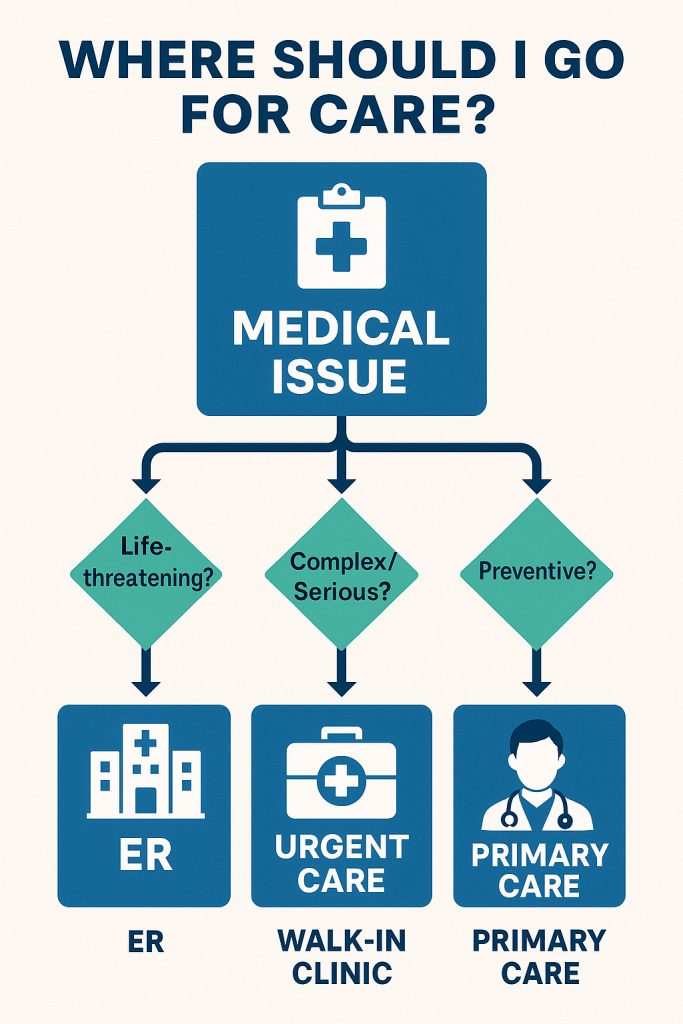Key Points
- Service scope and capabilities differ significantly, with urgent care centers offering more advanced medical procedures, on-site diagnostics, and treatment for complex conditions compared to basic walk-in clinics.
- Staffing and medical expertise vary substantially, as urgent care centers typically employ board-certified physicians and specialists, while walk-in clinics often rely primarily on nurse practitioners and physician assistants.
- Cost and insurance coverage considerations show urgent care centers generally cost more than walk-in clinics but provide greater value through comprehensive services and better insurance acceptance rates.

Navigating the modern healthcare landscape requires understanding the subtle but important differences between various types of medical facilities. Two options that often cause confusion are urgent care centers and walk-in clinics. While both provide convenient, appointment-free medical care, they serve different purposes and offer varying levels of service that can significantly impact your healthcare experience and outcomes.
The distinction between these two types of facilities has become increasingly important as healthcare consumers seek alternatives to expensive emergency room visits and hard-to-schedule primary care appointments. Understanding when to choose urgent care versus a walk-in clinic can save you time, money, and ensure you receive the most appropriate level of care for your specific medical needs.
Recent healthcare industry analysis shows that both urgent care centers and walk-in clinics have experienced significant growth, with urgent care centers seeing a 60% increase in visits from 2019 to 2020 [1]. This growth reflects the evolving needs of healthcare consumers who want convenient, accessible care without the complexity and cost of emergency department visits.
Defining Urgent Care Centers and Walk-In Clinics
Before exploring the differences between these healthcare options, it's essential to understand what each type of facility is designed to provide and how they fit into the broader healthcare ecosystem.
Urgent Care Centers: Comprehensive Acute Care
Urgent care centers represent a sophisticated approach to immediate medical care, designed to bridge the gap between primary care and emergency medicine. These facilities are specifically equipped and staffed to handle a wide range of acute medical conditions that require prompt attention but don't constitute life-threatening emergencies.
Urgent care centers typically operate with the infrastructure and capabilities to provide:
- Advanced diagnostic services including X-rays, laboratory testing, and EKGs
- Treatment for moderate to severe injuries and illnesses
- Minor surgical procedures and wound care
- Occupational health services and workers' compensation care
- Preventive care services and health screenings
Walk-In Clinics: Basic Immediate Care
Walk-in clinics, also known as retail clinics or convenience care clinics, focus on providing basic medical services for common, straightforward health issues. These facilities prioritize convenience and cost-effectiveness, making healthcare accessible for routine problems that don't require extensive medical evaluation.
Walk-in clinics typically specialize in:
- Treatment of minor illnesses like colds, flu, and ear infections
- Basic wound care and first aid
- Routine vaccinations and immunizations
- Simple health screenings and basic preventive care
- Prescription refills and medication management

1. Medical Services and Treatment Capabilities
The most significant difference between urgent care centers and walk-in clinics lies in the scope and complexity of medical services they can provide. This difference directly impacts the types of conditions each facility can effectively treat and the quality of care patients receive.
Urgent Care Center Capabilities
Urgent care centers are designed to handle a broad spectrum of medical conditions that require immediate attention but don't necessitate emergency department resources. Their expanded capabilities include:
Advanced Diagnostic Services
- Digital X-ray systems for bone fractures, chest conditions, and abdominal issues
- Laboratory testing including blood work, urinalysis, and rapid diagnostic tests
- Electrocardiogram (EKG) services for cardiac evaluation
- Ultrasound capabilities for soft tissue and internal organ assessment
- Point-of-care testing for immediate results
Complex Medical Procedures
- Suturing and wound closure for deep lacerations
- Fracture care including splinting and casting
- Joint injections and pain management procedures
- Minor surgical procedures and abscess drainage
- IV therapy and fluid replacement
Specialized Treatment Areas
- Occupational medicine and workers' compensation injuries
- Sports medicine and athletic injury care
- Travel medicine and international health services
- Chronic disease management and monitoring
- Mental health crisis intervention
Walk-In Clinic Services
Walk-in clinics focus on providing efficient, cost-effective care for common medical issues that don't require extensive diagnostic workup or complex treatment protocols. Their services typically include:
Basic Illness Treatment
- Upper respiratory infections and common colds
- Flu symptoms and seasonal illness management
- Ear infections and basic ENT conditions
- Urinary tract infections and simple bladder issues
- Skin rashes and minor allergic reactions
Routine Preventive Care
- Annual flu vaccinations and routine immunizations
- Basic health screenings including blood pressure checks
- Simple physical examinations for school or employment
- Prescription refills for stable chronic conditions
- Basic health education and counseling
Limited Diagnostic Capabilities
- Basic vital sign assessment and physical examination
- Simple urine testing and rapid strep tests
- Blood glucose monitoring for diabetes management
- Basic vision and hearing screenings
- Over-the-counter medication recommendations
2. Staffing and Medical Expertise
The level of medical expertise and staffing models represent another crucial difference between urgent care centers and walk-in clinics. These differences directly impact the quality of care, diagnostic accuracy, and treatment outcomes patients can expect.
Urgent Care Center Staffing Model
Urgent care centers typically employ a comprehensive medical team designed to provide hospital-quality care in an outpatient setting. This staffing approach ensures that patients receive appropriate medical attention from qualified professionals.
Physician Leadership
- Board-certified physicians in family medicine, internal medicine, or emergency medicine
- Medical directors with specialized training in urgent care medicine
- Physicians with hospital privileges and emergency department experience
- Specialists available for consultation and complex case management
Advanced Practice Providers
- Nurse practitioners with acute care certification and training
- Physician assistants specializing in urgent care medicine
- Advanced practice providers working under physician supervision
- Collaborative care models ensuring appropriate oversight and consultation
Support Staff Excellence
- Registered nurses with emergency and acute care experience
- Certified medical assistants trained in urgent care protocols
- Radiology technicians for on-site imaging services
- Laboratory technicians for immediate diagnostic testing
Walk-In Clinic Staffing Approach
Walk-in clinics typically operate with a streamlined staffing model focused on efficiency and cost-effectiveness for routine medical care. This approach works well for straightforward medical issues but may have limitations for complex conditions.
Primary Care Providers
- Nurse practitioners as primary care providers
- Physician assistants providing routine medical care
- Limited physician oversight, often through telemedicine or periodic visits
- Focus on protocol-driven care for common conditions
Support Staff
- Medical assistants for basic patient care and administrative tasks
- Limited nursing staff for routine procedures and patient education
- Administrative personnel for scheduling and insurance processing
- Minimal specialized technical staff
Supervision and Quality Assurance
- Remote physician oversight through electronic health records
- Standardized protocols for common conditions and treatments
- Limited on-site medical director presence
- Emphasis on efficiency and throughput over complex case management
3. Diagnostic Equipment and Technology
The availability of diagnostic equipment and medical technology represents a significant differentiator between urgent care centers and walk-in clinics. This difference affects the types of conditions that can be accurately diagnosed and treated at each facility type.
Urgent Care Center Technology Infrastructure
Modern urgent care centers invest heavily in diagnostic equipment and technology to provide comprehensive medical evaluation and treatment. This investment allows them to handle complex cases and provide definitive care for a wide range of conditions.
Imaging Capabilities
- Digital X-ray systems with immediate image availability
- Ultrasound equipment for soft tissue and organ evaluation
- CT scanning capabilities at larger urgent care facilities
- DEXA scanning for bone density assessment at specialized centers
- Mammography services at comprehensive urgent care locations
Laboratory Services
- Complete blood count (CBC) and comprehensive metabolic panels
- Cardiac enzyme testing for heart attack evaluation
- Coagulation studies and bleeding disorder assessment
- Toxicology screening and drug testing services
- Microbiology testing for infectious disease diagnosis
Cardiac Monitoring Equipment
- 12-lead EKG machines for comprehensive cardiac evaluation
- Cardiac monitoring equipment for unstable patients
- Stress testing capabilities for cardiac risk assessment
- Holter monitoring for rhythm disorder evaluation
- Blood pressure monitoring and hypertension management
Walk-In Clinic Technology Limitations
Walk-in clinics typically operate with basic diagnostic equipment sufficient for routine medical care but limited in scope for complex medical evaluation.
Basic Diagnostic Tools
- Simple examination equipment including otoscopes and stethoscopes
- Basic blood pressure and vital sign monitoring equipment
- Rapid diagnostic tests for strep throat and flu
- Simple urine testing capabilities
- Basic vision and hearing screening equipment
Limited Advanced Diagnostics
- No on-site X-ray or imaging capabilities
- Limited laboratory testing, often sent to external labs
- No cardiac monitoring or EKG services
- Minimal point-of-care testing options
- Reliance on external facilities for complex diagnostics
4. Cost Considerations and Insurance Coverage
Understanding the cost differences between urgent care centers and walk-in clinics helps patients make informed decisions about where to seek care based on their financial situation and insurance coverage.
Urgent Care Center Costs
Urgent care centers typically charge more than walk-in clinics due to their expanded services, advanced equipment, and higher staffing costs. However, they often provide better value through comprehensive care and diagnostic capabilities.
Typical Cost Ranges
- Basic urgent care visits: $150-$300 without insurance
- Complex urgent care visits with diagnostics: $300-$600
- X-rays and imaging services: $100-$300 additional
- Laboratory testing: $50-$200 depending on tests ordered
- Procedures and treatments: $100-$500 additional
Insurance Coverage Patterns
- Most major insurance plans cover urgent care visits
- Copays typically range from $30-$75 for insured patients
- Deductibles may apply for high-deductible health plans
- Workers' compensation and auto insurance often accepted
- Medicare and Medicaid coverage varies by location and provider
Walk-In Clinic Costs
Walk-in clinics generally offer lower costs due to their streamlined operations and limited service offerings. This cost advantage makes them attractive for routine care and patients paying out-of-pocket.
Typical Cost Ranges
- Basic walk-in clinic visits: $75-$150 without insurance
- Simple procedures and treatments: $25-$100 additional
- Vaccinations and immunizations: $20-$50 per vaccine
- Basic health screenings: $25-$75
- Prescription medications: Varies by medication and pharmacy
Insurance and Payment Options
- Many insurance plans cover walk-in clinic visits
- Lower copays, typically $15-$40 for insured patients
- Cash-pay discounts often available for uninsured patients
- Limited acceptance of workers' compensation and auto insurance
- Some clinics offer membership programs for frequent users
5. Wait Times and Convenience Factors
Both urgent care centers and walk-in clinics offer significant convenience advantages over traditional healthcare options, but they differ in their approach to patient flow and wait time management.
Urgent Care Center Wait Time Management
Urgent care centers typically use triage systems similar to emergency departments to prioritize patients based on medical acuity. This approach ensures that more serious conditions receive prompt attention while managing overall patient flow.
Typical Wait Times
- Average wait times: 15-45 minutes depending on acuity and volume
- Triage system prioritizes patients based on medical urgency
- Peak times (evenings and weekends) may have longer waits
- Online check-in systems available at many locations
- Real-time wait time updates through websites and apps
Convenience Features
- Extended hours including evenings and weekends
- No appointment necessary for most services
- Online registration and check-in options
- Text message updates on wait times and status
- Comfortable waiting areas with amenities
Walk-In Clinic Efficiency
Walk-in clinics prioritize efficiency and quick turnaround times, often seeing patients in the order of arrival for routine medical issues.
Typical Wait Times
- Average wait times: 10-30 minutes for routine visits
- First-come, first-served basis for most conditions
- Shorter visits due to limited scope of services
- Less variation in wait times due to consistent service offerings
- Quick turnaround for simple conditions and routine care
Operational Efficiency
- Streamlined processes for common conditions
- Limited services reduce complexity and wait times
- Efficient check-in and checkout procedures
- Minimal paperwork for routine visits
- Focus on high-volume, low-complexity care
6. Quality of Care and Patient Outcomes
The quality of care and patient outcomes represent critical factors in choosing between urgent care centers and walk-in clinics. Understanding these differences helps patients make informed decisions about their healthcare.
Urgent Care Center Quality Measures
Urgent care centers typically maintain higher quality standards due to their comprehensive staffing, advanced equipment, and broader scope of services.
Clinical Quality Indicators
- Board-certified physician oversight and direct patient care
- Comprehensive diagnostic capabilities leading to accurate diagnoses
- Ability to handle complex conditions and provide definitive treatment
- Lower rates of missed diagnoses due to advanced diagnostic tools
- Better outcomes for serious conditions requiring immediate intervention
Patient Safety Measures
- Comprehensive medical record systems and documentation
- Quality assurance programs and continuous improvement initiatives
- Infection control protocols and safety procedures
- Emergency response capabilities for unstable patients
- Coordination with emergency departments and hospitals when needed
Continuity of Care
- Integration with electronic health record systems
- Communication with primary care providers and specialists
- Follow-up care coordination and referral management
- Comprehensive treatment plans for complex conditions
- Medication management and drug interaction screening
Walk-In Clinic Quality Considerations
Walk-in clinics provide appropriate quality care for routine conditions within their scope of practice, but may have limitations for complex or serious medical issues.
Service Quality for Routine Care
- Effective treatment for common, straightforward conditions
- Appropriate care for routine preventive services
- Cost-effective management of minor illnesses and injuries
- Efficient service delivery for time-sensitive routine needs
- Adequate care for conditions within their treatment protocols
Limitations and Considerations
- Limited diagnostic capabilities may miss complex conditions
- Reduced physician oversight may affect diagnostic accuracy
- Inability to handle serious or complex medical conditions
- Limited follow-up care and continuity of care services
- Potential for inappropriate referrals due to limited capabilities
7. When to Choose Each Option
Making the right choice between urgent care centers and walk-in clinics depends on understanding your specific medical needs, the complexity of your condition, and your personal preferences for healthcare delivery.
Choose Urgent Care Centers For:
Complex or Serious Conditions
- Suspected fractures or significant injuries
- Chest pain or cardiac symptoms requiring EKG evaluation
- Severe abdominal pain or digestive issues
- Respiratory problems requiring chest X-rays
- Conditions requiring immediate diagnostic testing
Advanced Medical Needs
- Workers' compensation injuries requiring comprehensive evaluation
- Sports injuries needing specialized assessment and treatment
- Conditions requiring IV therapy or advanced procedures
- Follow-up care for serious medical conditions
- Situations where you need physician-level expertise
Comprehensive Care Requirements
- Multiple symptoms requiring thorough evaluation
- Conditions that might require referral to specialists
- Situations where you want definitive diagnosis and treatment
- Cases where you need extensive diagnostic workup
- Complex medication management or drug interactions
Choose Walk-In Clinics For:
Routine Medical Needs
- Common colds, flu, and upper respiratory infections
- Minor cuts and scrapes requiring basic wound care
- Routine vaccinations and immunizations
- Simple health screenings and preventive care
- Prescription refills for stable chronic conditions
Cost-Conscious Care
- Situations where you're paying out-of-pocket
- Routine care that doesn't require extensive evaluation
- Simple conditions with straightforward treatment protocols
- Preventive care and health maintenance services
- Basic occupational health requirements
Convenience-Focused Visits
- Quick visits for minor issues during busy schedules
- Routine care when your primary care provider isn't available
- Simple procedures that don't require physician oversight
- Basic health education and counseling needs
- Straightforward medication management
8. The Future of Urgent Care and Walk-In Clinics
Understanding the evolving landscape of urgent care and walk-in clinics helps patients anticipate how these services will continue to meet changing healthcare needs.
Urgent Care Evolution
The urgent care industry continues to expand its capabilities and services, moving toward more comprehensive care models that bridge the gap between primary care and emergency medicine.
Technology Integration
- Telemedicine capabilities for follow-up care and consultation
- Advanced diagnostic equipment including point-of-care testing
- Electronic health record integration with health systems
- Artificial intelligence for diagnostic assistance and triage
- Mobile health applications for patient engagement and monitoring
Service Expansion
- Mental health services and behavioral health support
- Chronic disease management programs
- Specialty care access through telemedicine partnerships
- Occupational health and wellness programs
- Preventive care and health maintenance services
Walk-In Clinic Adaptation
Walk-in clinics are adapting to changing healthcare needs by expanding their service offerings while maintaining their focus on convenience and cost-effectiveness.
Enhanced Services
- Expanded diagnostic capabilities through partnerships
- Telemedicine integration for complex case consultation
- Chronic disease monitoring and management programs
- Mental health screening and basic counseling services
- Enhanced preventive care and wellness programs
Technology Adoption
- Digital health platforms for patient engagement
- Remote monitoring capabilities for chronic conditions
- Electronic prescribing and medication management systems
- Online scheduling and virtual consultation options
- Integration with larger health system networks
Making Informed Healthcare Decisions
Choosing between urgent care centers and walk-in clinics requires careful consideration of your specific medical needs, financial situation, and preferences for healthcare delivery. Understanding the key differences outlined in this guide empowers you to make informed decisions that optimize both your health outcomes and healthcare costs.
Decision-Making Framework
When faced with a healthcare need, consider these factors:
- Severity and complexity of your medical condition
- Diagnostic requirements for accurate diagnosis and treatment
- Cost considerations including insurance coverage and out-of-pocket expenses
- Time sensitivity and urgency of your medical needs
- Follow-up care requirements and continuity of care needs
Quality Assurance Considerations
Regardless of which option you choose, ensure that the facility you select maintains appropriate quality standards:
- Verify provider credentials and licensing
- Confirm insurance acceptance and coverage details
- Understand the scope of services and limitations
- Ask about follow-up care and referral processes
- Ensure clear communication with your primary care provider
Conclusion
The choice between urgent care centers and walk-in clinics represents an important healthcare decision that can significantly impact your medical outcomes, costs, and overall healthcare experience. While both options provide valuable alternatives to emergency room visits and traditional primary care appointments, they serve different purposes and offer varying levels of service.
Urgent care centers excel in providing comprehensive, physician-led care for complex acute conditions, offering advanced diagnostic capabilities and treatment options that rival hospital emergency departments. Their higher costs are often justified by the quality and scope of care they provide, making them ideal for serious injuries, complex illnesses, and situations requiring immediate diagnostic evaluation.
Walk-in clinics offer an efficient, cost-effective solution for routine medical needs, providing convenient access to basic healthcare services without the complexity and expense of more comprehensive facilities. Their streamlined approach works well for common illnesses, routine preventive care, and straightforward medical issues that don't require extensive evaluation.
Understanding these differences empowers you to make informed healthcare decisions that align with your medical needs, financial situation, and personal preferences. By choosing the appropriate level of care for your specific situation, you can optimize both your health outcomes and healthcare costs while ensuring you receive timely, appropriate medical attention.
The future of healthcare lies in providing the right level of care at the right time and cost. Both urgent care centers and walk-in clinics play important roles in this evolving healthcare landscape, offering patients more choices and greater control over their healthcare decisions. By understanding when and why to use each option, you can navigate the healthcare system more effectively and take an active role in managing your health and wellness.
References:
[1] Urgent Care Association. "2023 Urgent Care Industry White Paper." https://urgentcareassociation.org/wp-content/uploads/2023-Urgent-Care-Industry-White-Paper.pdf
[2] Aetna. "Difference Between Emergency Room, Walk-in Clinic & Urgent Care." https://www.aetna.com/health-guide/medical-emergency-go-er-urgent-care.html
[3] FastTrack MD. "What's the Difference Between Urgent Care & Walk-In Clinics?" https://fastrackmd.com/blog/difference-between-urgent-care-walk-in-clinic/
[4] East Adam Rural Healthcare. "When to Choose a Walk-In Clinic vs Urgent Care." https://www.earh.org/when-to-choose-a-walk-in-clinic-vs-urgent-care








